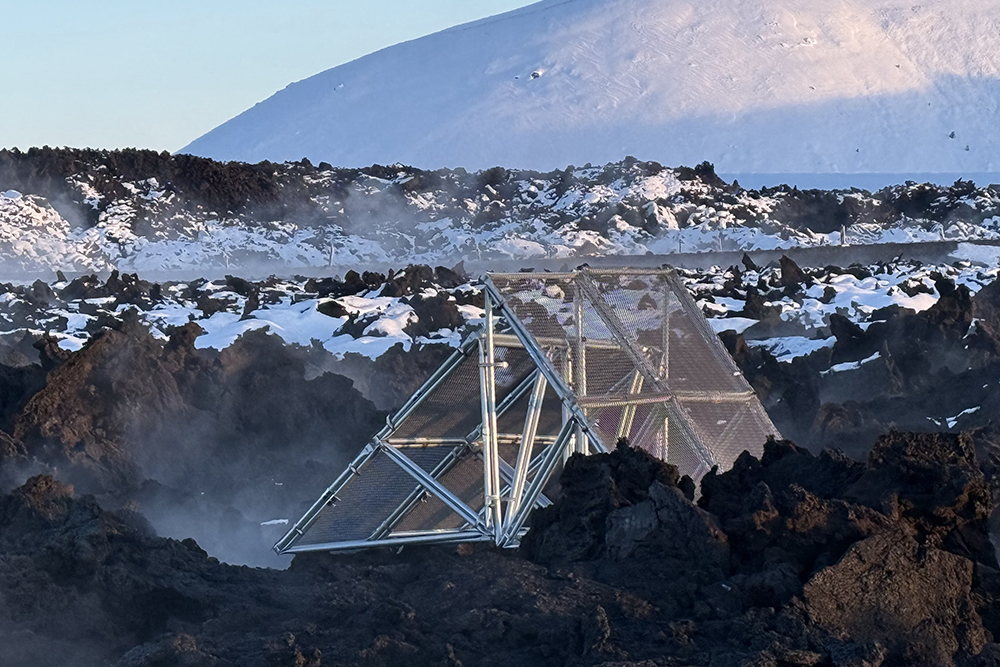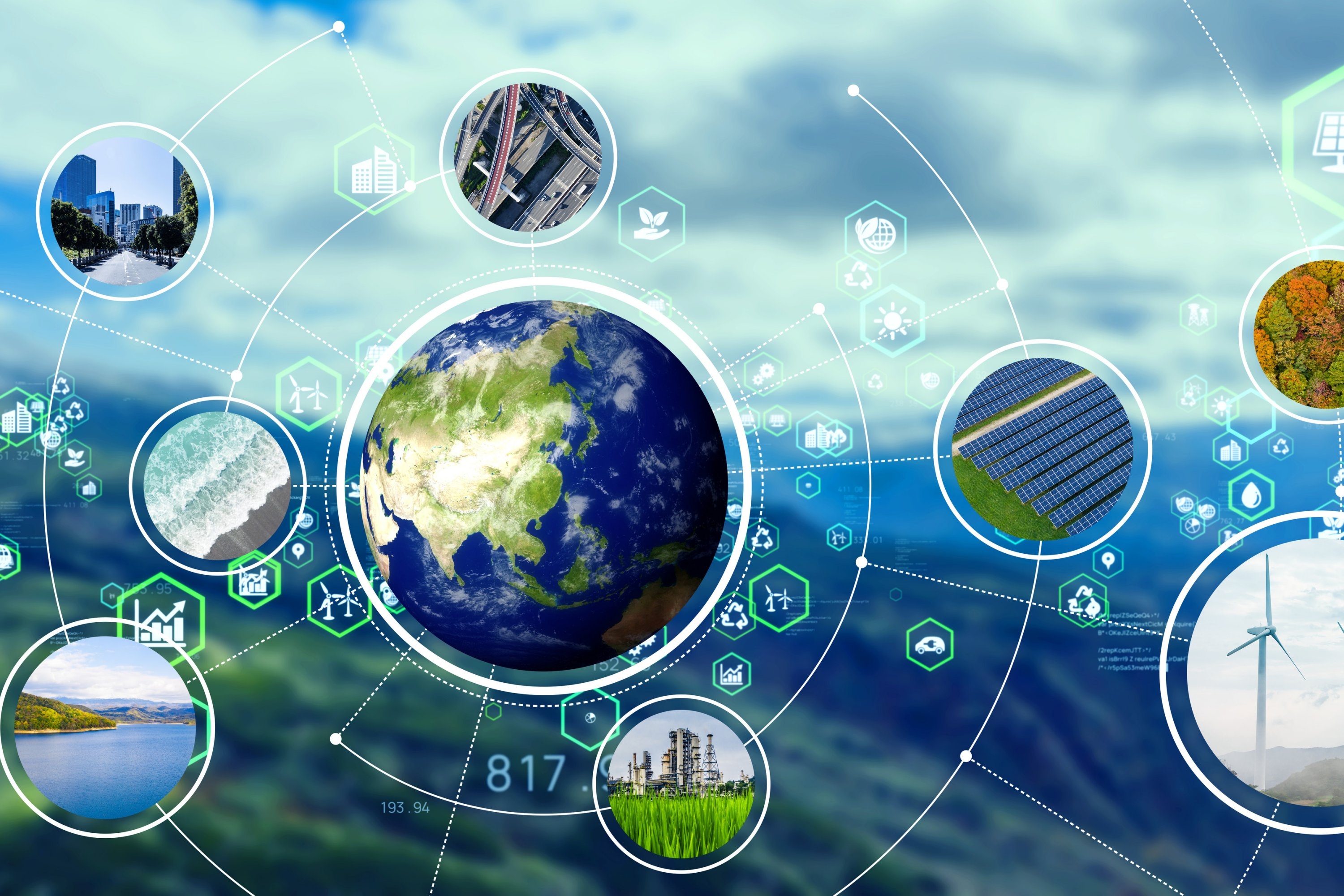
Collaborating with the force of nature
Ongoing research by three architecture faculty aims to yield structures that protect communities from the devastation of volcanic eruptions.
Common sense tells us to run from molten lava flowing from active volcanoes. But MIT professors J. Jih, Cristina Parreño Alonso, and Skylar Tibbits — faculty in the Department of Architecture at the School of Architecture and Planning — have their bags packed to head to southwest Iceland in anticipation of an imminent volcanic eruption. The Nordic island nation is currently experiencing a period of intense seismic activity; seven volcanic eruptions have taken place in its southern peninsula in under a year.
Earlier this year, the faculty built and placed a series of lightweight, easily deployable steel structures close to the volcano, where a few of the recent eruptions have taken place; several more structures are on trucks waiting to be delivered to sites where fissures open and lava oozes out. Cameras are in place to record what happens when the lava meets and hits these structures to help understand the lava flows.
This new research explores what type of shapes and materials can be used to interact with lava and successfully divert it from heading in the direction of habitats or critical infrastructure that lie in its path. Their work is supported by a Professor Amar. G. Bose Research Grant .
“We’re trying to imagine new ways of conceptualizing infrastructure when it relates to lava and volcanic eruptions,” says Jih, an associate professor of the practice. “Lovely for us as designers, physical prototyping is the only way you can test some of these ideas out.”
Currently, the
Icelandic Department of Civic Protection and Emergency Management
and an engineering group, EFLA, are diverting the lava with massive berms (approximately 44 to 54 yards in length and 9 yards in height) made from earth and stone.
Berms protecting the town of Grindavik, a power plant, and the popular Blue Lagoon geothermal spa have met with mixed results. In November 2024, a volcano erupted for the seventh time in less than a year, forcing the evacuation of town residents and the Blue Lagoon’s guests and employees. The latter’s parking lot was consumed by lava.
Sigurdur Thorsteinsson, chief brand, design, and innovation officer of the Blue Lagoon, as well as a designer and a partner in Design Group Italia, was on site for this eruption and several others.
“Some magma went into the city of Grindavik and three or four houses were destroyed,” says Thorsteinsson. “One of our employees watched her house go under magma on television, which was an emotional moment.”
While staff at the Blue Lagoon have become very efficient at evacuating guests, says Thorsteinsson, each eruption forces the tourist destination to close and townspeople to evacuate, disrupting lives and livelihoods.
“You cannot really stop the magma,” says Thorsteinsson, who is working with the MIT faculty on this research project. “It’s too powerful.”
Tibbits, associate professor of design research and founder and co-director of the Self-Assembly Lab, agrees. His research explores how to guide or work with the forces of nature .
Last year, Tibbits and Jih were in Iceland on another research project when erupting volcanoes interrupted their work. The two started thinking about how the lava could be redirected.
“The question is: Can we find more strategic interventions in the field that could work with the lava, rather than fight it?” says Tibbits.
To investigate what kinds of materials would withstand this type of interaction, they invited Parreño Alonso, a senior lecturer in the Department of Architecture, to join them.
“Cristina, being the department authority on magma, was an obvious and important partner for us,” says Jih with a smile.
Parreño Alonso has been working with volcanic rock for years and taught a series of design studios exploring volcanic rock as an architectural material. She also has proposed designing structures to engage directly with lava flows and recently has been examining volcanic rock in a molten state and melting basalt in MIT’s foundry with Michael Tarkanian, a senior lecturer in MIT’s Department of Materials Science and Engineering, and Metals Lab director. For this project, she is exploring the potential of molten rock as a substitute for concrete, a widely used material because of its pliability.
“It’s exciting how this idea of working with volcanoes was taking shape in parallel, from different angles, within the same department,” says Parreño Alonso. “I love how these parallel interests have led to such a beautiful collaboration.”
She also sees other opportunities by collaborating with these forces of nature.
“We are interested in the potential of generating something out of the interaction with the lava,” she says. “Could it be a landscape that becomes a park? There are many possibilities.”
The steel structures were first tested at MIT’s Metals Lab with Tarkanian and then built onsite in Iceland. The team wanted to make the structures lightweight so they could be quickly set up in the field, but strong enough so they wouldn’t be easily destroyed. Various designs were created; this iteration of the design has V-shaped structures that can guide the lava to flow around them, or they can be reconfigured as ramps or tunnels.
“There is a road that has been hit by many of the recent eruptions and must keep being rebuilt,” says Tibbits. “We created two ramps that could in the future serve as tunnels, allowing the lava to flow over the road and create a type of lava cave where the cars could drive under the cooled lava.”
Tibbits says they see the structures in the field now as an initial intervention. After documenting and studying how they interact with the lava, the architects will develop new iterations of what they believe will eventually become critical infrastructure for locations around the world with active volcanoes.
“If we can show and prove what kinds of shapes and structures and what kinds of materials can divert magma flows, I think it’s incredibly valuable research,” says Thorsteinsson.
Thorsteinsson lives in Italy half of the year and says the volcanoes there — Mount Etna in Sicily and Mount Vesuvius in the Gulf of Naples — pose a greater danger than those in Iceland because of the densely populated neighborhoods nearby. Volcanoes in Hawaii and Japan are in similarly populated areas.
“Whatever information you can learn about diverting magma flows to other directions and what kinds of structures are needed — it would be priceless,” he says.
Reprinted with permission of MIT News
